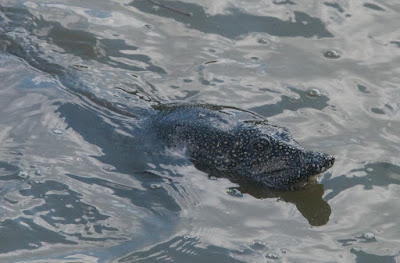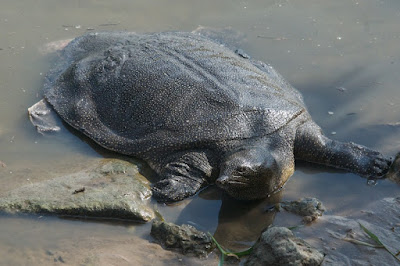Or rather, this little suburban waterway north of Tel Aviv is home to a whole population of monsters, and after the CITES Animals Committee meeting in Tel Aviv - on 5 September, 2015 - I joined two top turtle biologists, Thomas Leuteritz and my good friend Peter Paul van Dijk, on an excursion to see them.
We looked for them first, close to the river's mouth, at the sandy estuary where it empties into the Mediterranean.
No monsters there, I'm afraid. There were, however, a couple of decidedly non-monstrous Ringed Plovers (Charadrius hiaticula).
The dunes at the river mouth were decorated with clumps of a truly spectacular bulbous plant, the Sea Daffodil (Pancratium maritimum).
Sea Daffodils grow on sandy foreshores around much of the Mediterranean, from Portugal to Israel. Their beautiful flowers have attracted human attention for millenia; the oldest illustrations of Sea Daffodils are 3600-year-old Minoan wall paintings It also attracts the attention of migratory hawkmoths that are only able to pollinate the flowers when oceanside wind speeds are low enough to allow the moths to reach its flowers (for the fascinating details see here).
This female Banded Groundling (Brachythemis impartita) hardly qualifies as a monster either, unless you happen to be one of the insects it is likely to hunt.
We were, obviously, in the wrong part of the river, and it took several wrong turns through local suburbia before we found the right place: a little park, further upstream, with a boardwalk...
...and a viewing platform where children could lure the monsters into view with tasty bits of bread [note: not a good idea!].
The local fishes - perhaps Grey Mullets (Mugil cephalus), a marine fish that enters the river to breed - appreciated the bread too, but they were not the monsters we were looking for.
The monsters, though, were there all the same. They were Nile Softshells (Trionyx triunguis), the largest surviving reptiles in Israel and one of the largest freshwater turtles in the world. In parts of their broad range they can reach more than a metre in length and over 30 kg in weight - admittedly not a match for the immense (and almost extinct) Yangtze Giant Softshell (Rafetus swinhoei), which has reached nearly 250 kg, but make no mistake. These are big turtles.
There are two subgroups of Nile Softshell. One ranges widely through fresh waters in Africa, while the other once lived in scattered populations around the shores of the eastern Mediterranean, but today survives only on a few scattered colonies in Turkey and Israel. How genetically separate these two subgroups are is still debated, but there is no question that the Mediterranean subgroup is by far the rarer.
Pollution has been greatly reduced in the Alexander, and the 100+ turtles there form one of the healthier populations of the Mediterranean subgroup. There were, though, once twice that number. More than half were killed by flooding in 1991-1992.
The dunes at the river mouth were decorated with clumps of a truly spectacular bulbous plant, the Sea Daffodil (Pancratium maritimum).
Sea Daffodils grow on sandy foreshores around much of the Mediterranean, from Portugal to Israel. Their beautiful flowers have attracted human attention for millenia; the oldest illustrations of Sea Daffodils are 3600-year-old Minoan wall paintings It also attracts the attention of migratory hawkmoths that are only able to pollinate the flowers when oceanside wind speeds are low enough to allow the moths to reach its flowers (for the fascinating details see here).
This female Banded Groundling (Brachythemis impartita) hardly qualifies as a monster either, unless you happen to be one of the insects it is likely to hunt.
We were, obviously, in the wrong part of the river, and it took several wrong turns through local suburbia before we found the right place: a little park, further upstream, with a boardwalk...
...and a viewing platform where children could lure the monsters into view with tasty bits of bread [note: not a good idea!].
The local fishes - perhaps Grey Mullets (Mugil cephalus), a marine fish that enters the river to breed - appreciated the bread too, but they were not the monsters we were looking for.
The monsters, though, were there all the same. They were Nile Softshells (Trionyx triunguis), the largest surviving reptiles in Israel and one of the largest freshwater turtles in the world. In parts of their broad range they can reach more than a metre in length and over 30 kg in weight - admittedly not a match for the immense (and almost extinct) Yangtze Giant Softshell (Rafetus swinhoei), which has reached nearly 250 kg, but make no mistake. These are big turtles.
There are two subgroups of Nile Softshell. One ranges widely through fresh waters in Africa, while the other once lived in scattered populations around the shores of the eastern Mediterranean, but today survives only on a few scattered colonies in Turkey and Israel. How genetically separate these two subgroups are is still debated, but there is no question that the Mediterranean subgroup is by far the rarer.
Pollution has been greatly reduced in the Alexander, and the 100+ turtles there form one of the healthier populations of the Mediterranean subgroup. There were, though, once twice that number. More than half were killed by flooding in 1991-1992.
We were lucky. It is quite possible to stare into the murky waters of the river for a long time without seeing more than the tip of a snout protruding above the surface, but thanks to the local children and their bread supply, we got long, close views of a number of them.
Even up close, you might be forgiven for finding it hard to believe that the heads cruising above the water belong to turtles at all. These photos make them look like some sort of misshapen seal.
Once you get a good side view of their snorkel-like snouts, though, the resemblance to a seal disappears.
A good sign that the population is healthy was the presence of young animals as well as adults. We saw no really small animals (which, on consideration, might have been wise to stay out of reach of their predatory elders), but the younger ones were decorated with a myriad of bright yellow polka dots.
As they age, the spots fade...
...and eventually disappear...
Once you get a good side view of their snorkel-like snouts, though, the resemblance to a seal disappears.
A good sign that the population is healthy was the presence of young animals as well as adults. We saw no really small animals (which, on consideration, might have been wise to stay out of reach of their predatory elders), but the younger ones were decorated with a myriad of bright yellow polka dots.
As they age, the spots fade...
...and eventually disappear...































No comments:
Post a Comment